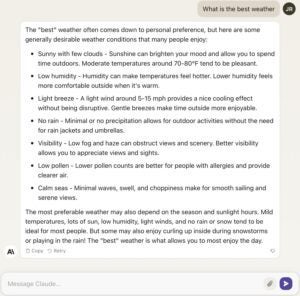ChatGPT-4 and Claude are both leading AI applications that provide generative AI for business and consumer uses.
GPT-4 is the latest version of ChatGPT, the popular AI application that can create articles and computer code and perform various tasks. GPT-4 is supported by OpenAI and Microsoft.
Claude is created by Anthropic and is a newer application in the AI field. It’s often used mainly as an AI chatbot, and doesn’t have the full functionality of GPT-4. Claude is supported by Google, Zoom and Slack, and has received significant investment over the last several months.
So which generative AI app is best, GPT-4 or Claude 2? In this comparison of ChatGPT and Claude, we analyze both application’s key features, pricing, and pros and cons to help you determine the best AI solution for your needs.
TABLE OF CONTENTS
GPT-4 vs. Claude: Head-to-Head Comparison
Here is a head-to-head feature comparison of GPT-4 and Claude.
| GPT-4 | Claude | |
|---|---|---|
| Developed by | OpenAI | Anthropic |
| Pricing | $20 a month, plus additional fees for volume used | $20 per month plus tax |
| Free plan | Yes with ChatGPT, No with GPT-4 | Yes (Beta model) |
| Language availability | 200+ | 10+ |
| Long-form content | Better | Good |
| Maximum context length | 32k (32,000) tokens | 100,000 tokens |
| Chatbot functions | Good | Good |
| Data processing | Superior | Adequate |
| Visual input | Yes | No |
| Originality rate | High | Moderate |
| Image Interpretation | Good | Absent |
| Parameters analyzed | Trillions from the web | Limited to specific data sets requested |
| Ethics | N/A | Constitution-inspired responses |
| Integration | Good | Very good |
| Programming accuracy | Good | Fair but basic |
| Use cases | ChatGPT, marketing content, Copilot | Legal analysis, Math, content moderation |
What is GPT-4?
ChatGPT is an abbreviation for Generative Pre-trained Transformer, a form of advanced artificial intelligence (AI). GPT4 simulates thought by using a neural network machine learning model trained on a vast trove of data gathered from the internet.
GPT-4 goes far beyond being a chatbot. This generative AI app creates documents and articles and solves problems. GPT-4 can also perform image interpretation using multimodal language AI models. This enables it to build websites based on sketches and suggest recipes based on a photo of what is in the fridge or sitting on a countertop.
Below is an example that demonstrates that GPT-4 provides more effective responses than its earlier version:

To learn more about the popular GPT platform, see: ChatGPT: Understanding the ChatGPT ChatBot
What is Claude 2?
Claude 2 is an AI assistant from Anthropic that is accessible through a chat interface or API. It is capable of conversational and text processing. Use cases include summarization, search, creative and collaborative writing, formulating Q&A and some basic coding.
It gives fast responses to customer service requests and can hand off tasks to a human when needed. Claude is particularly good at editing, rewriting, summarizing, classifying and extracting structured data. It can also follow basic instructions and logical scenarios, analyze strategic risks and opportunities based on annual reports, assess the pros and cons of a piece of legislation and identify risks in legal documents.
Claude can provide lengthy answers to questions requiring fact or opinion. Below is Claude’s answer to “what is the best weather?”

GPT-4 vs. Claude 2: Feature Comparison
GPT-4 and Claude are at the center of the generative AI battle royale in the technology sector. Let’s compare their key features to help determine the best option for you.
GPT-4 vs. Claude: Chatbot Functions
GPT-4 is used a lot in chatbot applications to automate customer service, answer FAQs, and engage in conversation. It can respond conversationally by tapping into a comprehensive set of online text, as well as news items, novels, websites, and more.
Overall, GPT-4 does a good job of analyzing information, evaluating online behavior, and even makes product recommendations as part of the online sales and upselling process. Automation features extend to appointment scheduling, reservations, payment processing, queries about shipping schedules, order progress, product returns, product and service availability, all with a good level of accuracy.
Claude can be viewed as more of a focused AI chatbot than GPT-4. It can be tailored to certain use cases and data sets such as customer service, legal, back office and sales. It can also be taught when to hand off tasks to a human.
You define the data set to analyze, summarize or use for context, and it can respond conversationally. It can speak a variety of common languages, as well as programming languages. However, it doesn’t search the internet like GPT-4. You can provide Claude with text from the internet and ask it to perform tasks with that content.
Verdict: GPT-4 wins overall – but Claude may prove better at narrower AI chatbot use cases.
GPT-4 vs. Claude: Accuracy of Response
ChatGPT can be prone to be error-based, because some of its data may not be current. GPT-4 added a greater degree of accuracy. OpenAI stated that GPT-4 is 82% less likely than its predecessor to respond to requests for content that OpenAI does not allow, and 60% less likely to invent answers. But don’t expect it to be perfect. That includes coding – its programming output should always be verified by human eyes.
Claude is also prone to errors. Some believe Claude is better at answering queries as it takes answers from a narrower data set. This is beneficial in areas such as history, geography and entertainment. A big difference between Claude and GPT-4 is that Claude can admit that it doesn’t know.
Verdict: This category is even. GPT-4 is more accurate than Claude in many areas, yet Claude’s accuracy is better in some use cases.
For a fuller understanding of how AI enables GPT and Claude to work, read: What is Generative AI?
GPT-4 vs. Claude: Integration
GPT can be plugged into other applications to generate responses via an API. Plugins are becoming available, including those for the likes of Kayak, Expedia, OpenTable, Slack and Shopify, with more on the way. It is also integrated with a lot of different programming languages.
Claude has done an excellent job of developing partners, too. They include Notion, Quora, DuckDuckGo, Slack and Zoom. Watch out for tighter Google integration going forward, too. Claude can integrate with a wide range of apps via API.
The Claude App for Slack can summarize threads and answer questions. For Zoom, Claude is being integrated into the Zoom contact center, meetings, phone, team chat, whiteboard, and Zoom IQ.
Verdict: Both integrate well, but Claude perhaps comes out slightly ahead.
GPT-4 vs. Claude: Security
Unfortunately, there’s not a lot to say about the security of these two AI platforms, because they are so new, and security has not been a driving focus as they’ve been built. Expect this to change going forward, but in any case, it’s never a good idea to create AI prompts from sensitive business information.
Chat-GPT does claim that it has worked with over 50 experts to develop improved security. Claude, to its credit, uses industry-standard best practices for data handling and retention. But, again, neither AI platform is intended for private business information.
Verdict: Neither is particularly well known for security, but Claude gets the nod.
For more comparisons of generative AI applications: ChatGPT vs. Google Bard
GPT-4 vs. Claude: Pricing
GPT-4 pricing
GPT-4 has a basic version available for free but the main ChatGPT Plus version costs roughly $20/month. Subscribers gain access to ChatGPT at peak times, faster responses, and priority access to new features and improvements.
On top of the basic subscription, there is a pricing scale per 1,000 tokens (chunks of words). 1,000 tokens comes out to about 750 words of material. The higher rate provides access to a larger set of contextual data.
| Model | Input | Output |
|---|---|---|
| GPT-4 | $0.03 per 1K tokens | $0.06 per 1K tokens |
| GPT-4-32k | $0.06 per 1K tokens | $0.12 per 1K tokens |
Claude Pricing
Claude 2 has a subscription and pricing scale options. The subscription plan, Claude Pro, costs $20 per month plus tax. There are three scale versions of Claude. Claude Instant is a lighter, less expensive and much faster option. Claude 2 is the high-performance version that can take care of sophisticated dialogue and creative content generation as well as detailed instruction following. Claude 2.1 offers the same performance as Claude 2 with reduction in AI hallucination rates.
For context, 100,000 tokens works out to roughly 70,000 words or six hours of audio.
| Model | Context window | Input (Prompt) | Output (Completion) |
|---|---|---|---|
| Claude Instant | 100,000 tokens | $0.80 per million tokens | $2.40 per million tokens |
| Claude 2 | 100,000 tokens | $8.00 per million tokens | $24.00 per million tokens |
| Claude 2.1 | 200,000 tokens | $8.00 per million tokens | $24.00 per million tokens |
Verdict: Due to the added monthly subscription in GPT-4, it is hard to be certain who wins in the long term. But it looks like Claude 2 wins on pricing.
Pros and Cons of GPT-4
ChatGPT has a higher profile than Claude – more total users – yet it is also prone to hallucinations, and is a little slower.
| Pros | Cons |
|---|---|
| GPT-4 can process different text files like PDFs, CSVs, TXT, Markdown or images, audio | More likely to provide nonsensical statements |
| Supports 200+ languages | Slow response time compared to Claude |
| Public to all customers who have OpenAI account | |
| Wider general knowledge |
Pros and Cons of Claude 2
Claude is known to be a fast AI chatbot, but its list of languages is far smaller.
| Pros | Cons |
|---|---|
| Fast response to questions | Limited to 10 languages |
| Provide step-by-step and logical explanation to mathematical questions | Limited availability |
| Superior performance in fields like law, mathematics, and coding | |
| Avoiding contradictory or nonsensical statements |
Bottom Line: GPT-4 vs. Claude
GPT-4 uses a transformer-based architecture as part of a neural network that handles sequential data. It appears to perform capably in coding, and does a very good job on chat, language translation, answering questions, understanding images, and can even determine why a joke is funny. GPT-4 has thrown its hat in the ring with Microsoft – which offers many benefits in terms of development and support.
Claude, on the other hand, gains from Google’s support. It is less comprehensive than GPT-4 but can respond without searching the internet. It does a good job of digesting, summarizing and explaining financial documents and research papers. Like all AI chatbots, it may sometimes assess its own ability or memory incorrectly, make up information, and make errors in complicated arithmetic. But certainly GPT-4 makes errors, too.
Claude is very much a work in progress, it’s not as comprehensive as GPT-4 right now. Give it a few months and we’ll see how far it comes. But for now, GPT-4 has greater functionality.
For more about new companies that are influencing the future of AI applications like GPT and Claude: Generative AI Startups